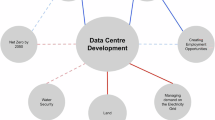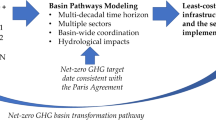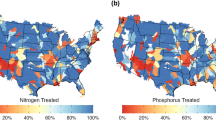Abstract
The world is facing a serious problem of water infiltration in buildings, which threatens urban safety and sustainability. Although building waterproofing engineering has made much progress, it remains largely experience-driven and cannot guarantee the reliability and low-carbon attributes of building waterproofing projects under climate change. As a result, the building waterproofing industry stands at a critical turning point, urgently needing innovations that prioritize both reliability and low-carbon emissions. This Perspective proposes a new strategy for sustainability-based building waterproofing design, explores future directions and provides low-carbon recommendations for policymakers, researchers, designers and technicians.
This is a preview of subscription content, access via your institution
Access options
Subscribe to this journal
Receive 12 digital issues and online access to articles
118,99 € per year
only 9,92 € per issue
Buy this article
- Purchase on SpringerLink
- Instant access to full article PDF
Prices may be subject to local taxes which are calculated during checkout



Similar content being viewed by others
References
Zhu, H. et al. A universal, multifunctional, high-practicability superhydrophobic paint for waterproofing grass houses. NPG Asia Mater. 13, 47 (2021).
Xiao, J. Building Waterproofing Foundation [in Chinese] (China Architecture Industry Press, 2018).
Shin, J., Son, S. & Cha, Y. Spatial distribution modeling of customer complaints using machine learning for indoor water leakage management. Sustain. Cities Soc. 87, 104255 (2022).
Cun, C., Zhang, W., Che, W. & Sun, H. Review of urban drainage and stormwater management in ancient China. Landsc. Urban Plan. 190, 103600 (2019).
Wescoat, J. L. Jr Comparing ancient water infrastructure for new cities. Landsc. Archit. Front. 2, 56–68 (2014).
Li, S. et al. Change of extreme snow events shaped the roof of traditional Chinese architecture in the past millennium. Sci. Adv. 7, eabh2601 (2021).
Mouaddib, E. M., Pamart, A., Pierrot-Deseilligny, M. & Girardeau-Montaut, D. 2D/3D data fusion for the comparative analysis of the vaults of Notre-Dame de Paris before and after the fire. J. Cult. Herit. 65, 221–231 (2024).
Xiao, J. & Zou, S. Cement at 200: towards net-zero fully recycled concrete. Nature 631, 740 (2024).
Monteiro, P. J. M., Miller, S. A. & Horvath, A. Towards sustainable concrete. Nat. Mater. 16, 698–699 (2017).
Di Luca, G., Filomia, M., Fuoco, A., Chiappetta, G. & Figoli, A. Effect of graphene oxide on liquid water-based waterproofing bituminous membranes. Polymers (Basel) 14, 2221 (2022).
Lin, B. B. et al. Holistic climate change adaptation for World Heritage. Nat. Sustain. 6, 1157–1165 (2023).
Zhang, C. 1,783 cultural relics in Shanxi Province were damaged to varying degrees, and nearly half of them were “immovable”. Beijing News (13 October 2021); https://www.bjnews.com.cn/detail/163409789914139.html
Guo, S. et al. A critical review of corrosion development and rust removal techniques on the structural/environmental performance of corroded steel bridges. J. Clean. Prod. 233, 126–146 (2019).
Jiang, Z., Pan, Y., Lu, J. & Wang, Y. Pore structure characterization of cement paste by different experimental methods and its influence on permeability evaluation. Cem. Concr. Res. 159, 106892 (2022).
Surfside condominium collapse. Wikipedia https://en.wikipedia.org/wiki/Surfside_condominium_collapse (accessed 8 June 2025).
Asakura, T. & Kojima, Y. Tunnel maintenance in Japan. Tunnelling Undergr. Space Technol. 18, 161–169 (2003).
Peng, H. et al. Characteristics analysis of leakage diseases of Beijing underground subway stations based on the field investigation and data statistics. Transp. Geotech. 48, 101317 (2024).
Koch G., et al. International Measures of Prevention, Application, and Economics of Corrosion Technologies Study (NACE International, 2016).
Zhang, B. Research on On-line Monitoring System for Leakage Positions in Waterproof Membrane Based on Intelligent Sense. Masters thesis, Zhengzhou Univ. (2022).
Kenny. Will the relaxation of the construction industry supervision lead to another leaky housing crisis? New Zealand Chinese Herald (30 October 2024); https://www.chineseherald.co.nz/news/property/building-consent-reform/
Qian, J. & Gu, Y. Research on anti leakage construction of building engineering exterior wall based on improved attribute recognition model. Case Stud. Constr. Mater. 17, e01410 (2022).
China National Building Waterproof Association. Resident of the 4th floor experiences rainwater penetration through walls: uncovering the "three 65% leakage patterns". China National Building Waterproof Association Network http://www.cnwb.net/search/searchcontent/12665.html?keywords=65%252 (2013).
He, Y. et al. A high environmental composite quality factor score was associated with the risk of sick building syndrome among adults in northeast China. J. Environ. Manage. 306, 114458 (2022).
Thomas, S. et al. Chronic mould exposure as a risk factor for severe community acquired pneumonia in a patient requiring extra corporeal membrane oxygenation. Respir. Med. Case Rep. 15, 39–41 (2015).
Gonçalves, M., Silvestre, J. D., de Brito, J. & Gomes, R. Environmental and economic comparison of the life cycle of waterproofing solutions for flat roofs. J. Build. Eng. 24, 100710 (2019).
Liu, Z., Deng, Z., Davis, S. & Ciais, P. Monitoring global carbon emissions in 2022. Nat. Rev. Earth Environ. 4, 205–206 (2023).
Liu, Z., Deng, Z., Davis, S. & Ciais, P. Global carbon emissions in 2023. Nat. Rev. Earth Environ. 5, 253–254 (2024).
Paszkowski, A. et al. Climate threats to coastal infrastructure and sustainable development outcomes. Nat. Clim. Change 14, 344–352 (2024).
Ombadi, M., Risser, M. D., Rhoades, A. M. & Varadharajan, C. A warming-induced reduction in snow fraction amplifies rainfall extremes. Nature 619, 305–310 (2023).
Trenberth, K. E. Changes in precipitation with climate change. Clim. Res. 47, 123–138 (2011).
Ham, Y.-G. et al. Anthropogenic fingerprints in daily precipitation revealed by deep learning. Nature 622, 301–307 (2023).
Murakami, H. et al. Detected climatic change in global distribution of tropical cyclones. Proc. Natl Acad. Sci. USA 117, 10706–10714 (2020).
Hu, Y. et al. State of the art: multiscale evaluation of bitumen ageing behaviour. Fuel 326, 125045 (2022).
Ahmad, M., Khedmati, M., Mensching, D., Hofko, B. & Haghshenas, H. F. Aging characterization of asphalt binders through multi-aspect analyses: a critical review. Fuel 376, 132679 (2024).
Al-Bahar, S. Moisture effect on selected polymer-based membranes used for waterproofing building basements. Polym. Compos. 26, 276–286 (2005).
Atanane, O., Mourhir, A., Benamar, N. & Zennaro, M. Smart buildings: water leakage detection using TinyML. Sensors 23, 9210 (2023).
Olsson, L. Rain resistance of façades with façade details: a summary of three field and laboratory studies. J. Build. Phys. 41, 521–532 (2017).
DeOreo, W. B., Mayer, P., Dziegielewski, B. & Kiefer, J. Residential End Uses of Water, Version 2 (Water Research Foundation, 2016).
2013 National Building Water Infiltration Survey Project Report (China National Building Waterproof Association, 2013).
Kot, P., Ali, A. S., Shaw, A., Riley, M. & Alias, A. The application of electromagnetic waves in monitoring water infiltration on concrete flat roof: the case of Malaysia. Constr. Build. Mater. 122, 435–445 (2016).
Xiao, J., Yu, C., Xiao, X., Ding, T. & Zhang, Y. Fundamental problems and development paths for reclamation of waste waterproof membranes. Strateg. Stud. Chin. Acad. Eng. 25, 210–221 (2023).
Shen, C. Design of Building Waterproofing Engineering (China Architecture Industry Press, 2008).
Yi, S.-T., Hyun, T.-Y. & Kim, J.-K. The effects of hydraulic pressure and crack width on water permeability of penetration crack-induced concrete. Constr. Build. Mater. 25, 2576–2583 (2011).
Ghanate, K., Khanverdi, M. & Das, S. Wind-driven rainwater penetration through brick veneer with and without surface treatments. J. Build. Eng. 62, 105347 (2022).
Van Linden, S. & Van Den Bossche, N. Pre-compressed foam sealing tapes to seal joints between building envelope components watertight: an experimental assessment. Buildings 13, 661 (2023).
Gong, C., Ding, W. & Mosalam, K. M. Performance-based design of joint waterproofing of segmental tunnel linings using hybrid computational/experimental procedures. Tunnelling Undergr. Space Technol. 96, 103172 (2020).
Liu, X., Kasbergen, C., Li, J. & Scarpas, T. Modelling of membrane bonding response: part 1 development of an adhesive contact interface element. Int. J. Pavement Eng. 23, 612–625 (2020).
Liu, J. & Tan, Y. Review of through-wall leaking incidents during excavation of the subway stations of Nantong metro line 1 in thick water-rich sandy strata. Tunnelling Undergr. Space Technol. 135, 105056 (2023).
Mohd Yussof, N. A. & Ho, H. W. Review of water leak detection methods in smart building applications. Buildings 12, 1535 (2022).
Hu, X., Han, Y., Yu, B., Geng, Z. & Fan, J. Novel leakage detection and water loss management of urban water supply network using multiscale neural networks. J. Clean. Prod. 278, 123611 (2021).
Pan, W. et al. Degradation mechanisms of polyurethane grouting materials under quasi-static and cyclic compression loading: density and size effects. Constr. Build. Mater. 408, 133795 (2023).
Safan, M. A., Etman, Z. A. & Konswa, A. Evaluation of polyurethane resin injection for concrete leak repair. Case Stud. Constr. Mater. 11, e00307 (2019).
Mendes, P., Lopes, J. G., de Brito, J. & Feiteira, J. Waterproofing of concrete foundations. J. Perform. Constr. Facil. 28, 242–249 (2014).
Liu, G. Shanghai EXPO theme pavilion basement waterproofing project [in Chinese]. New Build. Mater. 7, 66–69 (2010).
Shen, L. & Wu, P. Waterproofing construction plan for ultra-deep basement [in Chinese]. China Building Waterproofing 11, 50–53 (2024).
Shenzhen Waterproof Association. Upgrading and repair is the main theme of the waterproofing industry in the future! Shenzhen Waterproof Network http://www.szfsxh.com/newsinfo/?id=2518 (2020).
Liu, Y. Quality Defects and Prevention of Building Waterproof Engineering. Masters thesis, Hubei Univ. of Tech. (2017).
China National Building Waterproof Assocation. 2024 China International Roofing and Waterproofing Expo will be held on Oct 16-18, in Shanghai. China National Building Waterproof Association Network https://cnwb.net/list/newscontent/43314.html (2024).
China National Building Waterproof Association. Launch meeting of a project under China's National Key Research and Development Program successfully held in Hubei Zhuobao. China National Building Waterproof Association Network https://www.cnwb.net/list/newscontent/39523.html (2023).
Ministry of Housing and Urban-Rural Development of the People’s Republic of China. Announcement of the Ministry of Housing and Urban-Rural Development on the release of the National Standard General Code for Waterproofing of Buildings and Municipal Engineering. Network of Ministry of Housing and Urban-Rural Development of the People's Republic of China https://www.mohurd.gov.cn/gongkai/zc/wjk/art/2022/art_17339_768499.html (2022).
China National Building Waterproof Association. Twenty-eight committee members have taken office! The Vocational Education Working Committee of China National Building Waterproof Association has been officially established! China National Building Waterproof Association Network https://www.cnwb.net/list/newscontent/35836.html (2021).
United Nations. The 17 goals. The Global Goals https://www.globalgoals.org/goals/ (2015).
2019 Global Status Report for Buildings and Construction (International Energy Agency, 2019).
Bibi, T. S. & Tekesa, N. W. Impacts of climate change on IDF curves for urban stormwater management systems design: the case of Dodola Town, Ethiopia. Environ. Monit. Assess. 195, 170 (2023).
Hazleden, D. G. A decay risk model for wood frame walls using the 4Ds with special reference to New Zealand. J. Build. Eng. 49, 104070 (2022).
Dalhat, M. A. & Adesina, A. Y. Characterization and evaluation of micronized tire rubber asphalt surface for improved hydrophobicity. J. Mater. Civil Eng. 31, 04019229 (2019).
Yu, C. & Yang, Q. Double effects of oxidative aging on carbon nanotube–asphalt nanocomposite interfaces: enhancement and deterioration. Langmuir 39, 14102–14118 (2023).
Wang, B. et al. Effect of vacuum–vibration–compaction molding on the properties and performances of polymer-modified cementitious material. Cem. Concr. Compos. 148, 105450 (2024).
Xia, B., Xiao, J. & Li, S. Sustainability-based reliability design for reuse of concrete components. Struct. Saf. 98, 102241 (2022).
Xia, B., Ding, T. & Xiao, J. Life cycle assessment of concrete structures with reuse and recycling strategies: a novel framework and case study. Waste Manag. 105, 268–278 (2020).
Xiao, J. et al. Prospects for low-carbon design theory of concrete structures. Chin. Sci. Bull. 67, 3425–3438 (2022).
Xia, B., Xiao, J., Ding, T. & Zhang, K. Probabilistic sustainability design of structural concrete components under climate change. Struct. Saf. 92, 102103 (2021).
Acknowledgements
We acknowledge financial support from the National Key Research and Development Program of China (2022YFC3803401), the Science and Technology Major Project of Guangxi Province (AA24263035) and the Portuguese Foundation for Science and Technology (UIDB/04625/2020). We thank X. Liu of the Delft University of Technology for his advice, and Beijing Oriental Yuhong Waterproof Technology Co. for providing the innovative building waterproofing cases.
Author information
Authors and Affiliations
Contributions
J.X. and C.Y. drafted the initial outline and core content of the paper. B.X. participated in discussions throughout the project. X.X., F.W., J.K. and J.d.B. provided constructive comments and polished the language.
Corresponding author
Ethics declarations
Competing interests
The authors declare no competing interests.
Peer review
Peer review information
Nature Cities thanks Zhen Leng, Shi-Jie Cao and the other, anonymous, reviewer(s) for their contribution to the peer review of this work.
Additional information
Publisher’s note Springer Nature remains neutral with regard to jurisdictional claims in published maps and institutional affiliations.
Rights and permissions
Springer Nature or its licensor (e.g. a society or other partner) holds exclusive rights to this article under a publishing agreement with the author(s) or other rightsholder(s); author self-archiving of the accepted manuscript version of this article is solely governed by the terms of such publishing agreement and applicable law.
About this article
Cite this article
Xiao, J., Yu, C., Xia, B. et al. Low-carbon solutions for water infiltration in urban buildings under climate change. Nat Cities 2, 479–488 (2025). https://doi.org/10.1038/s44284-025-00259-1
Received:
Accepted:
Published:
Issue Date:
DOI: https://doi.org/10.1038/s44284-025-00259-1



